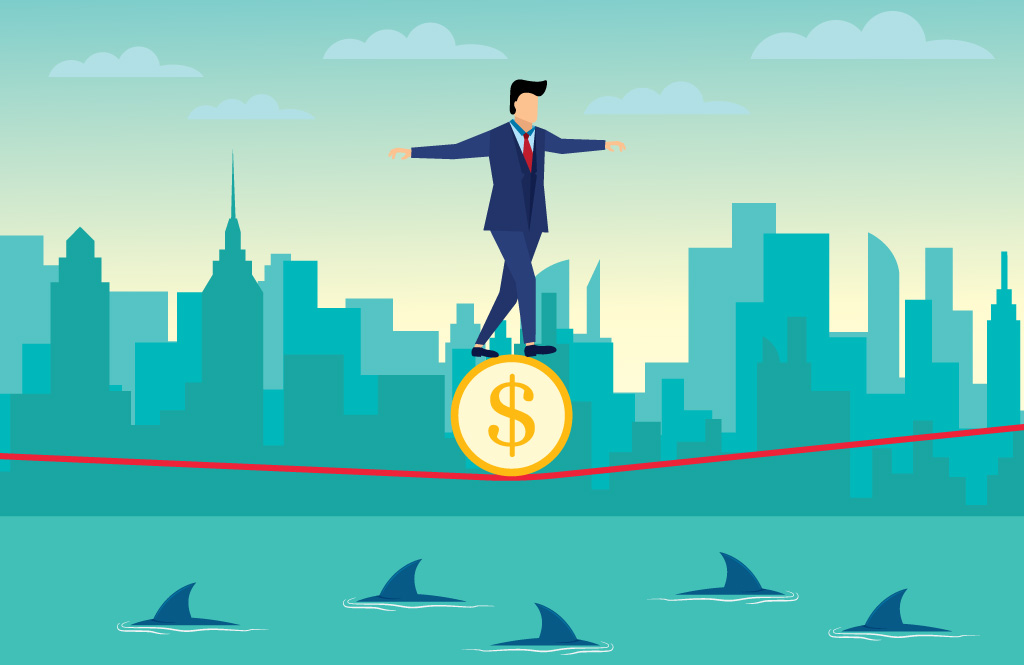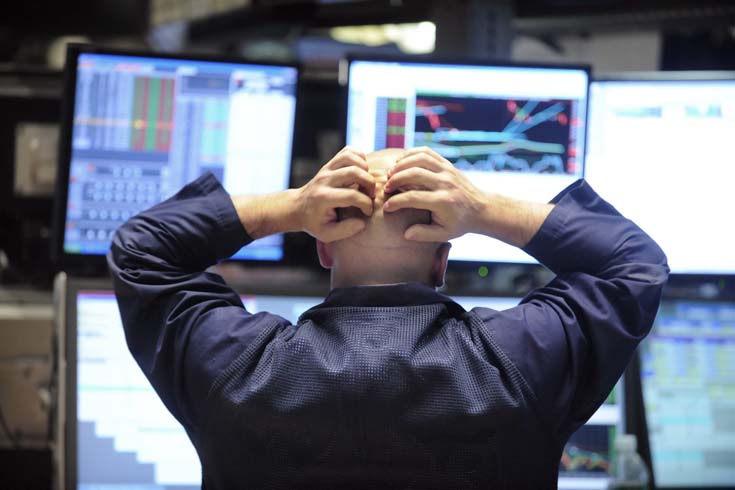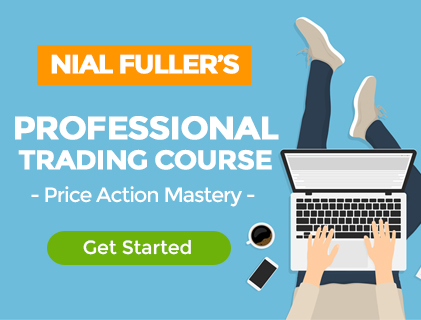
So you want to become a successful trader? Well, you are going to have to avoid making many common mistakes that traders often fall victim to. You’re GOING to make mistakes as you learn to trade, but the traders who actually start making money are the ones who LEARN from those mistakes and figure out how to stop committing them over and over. In this lesson, I am going to discuss the most common mistakes that traders make and give you some simple solutions to them. After that, it’s up to you to learn from them and make sure to avoid them as you continue to analyze and trade the markets.
Being in Too Many Trades at Once and Over-Trading
This is perhaps the most classic mistake that 100% of beginners make and about 90% of the rest make. Also, it’s no surprise that about 90% of traders lose money over the long-run when about 90% of them are trading too much. Another interesting tid-bit is that if you find you’re in more than one trade at a time, you’re probably trading too much. There really is no logical reason to be in more than one trade at a time, ever.
Most people simply cannot learn to ignore the temptation to constantly be in a trade, so they make up all sorts of reasons why they should trade or they make up trading signals that aren’t really there. The cold hard truth of it all is, unless you learn to control yourself and stop over-trading, you are never going to make consistent money trading the markets.
Perhaps the quickest and easiest way to train yourself to stop over-trading is simply to change the way you think about trading and what “making money trading” actually consists of. Once you start remembering that less is more and that you will literally MAKE MORE MONEY by TRADING LESS over time, you will begin to look for reasons why a potential trade might not work out, instead of trying to find any little reason possible to enter the market (like most traders do).
Spending Too Much Time Thinking about Trading and Looking at Charts
Similar to over-trading, is generally just thinking about trading too much. Traders often make the mistake of spending too much time flipping through the charts over and over, even when there are no obvious price action signals to trade. As a result, what ends up happening is that they enter a trade they wouldn’t normally take if they where following their trading plan.
If you find yourself at the point where you are thinking about the markets and trading / trades you’re in, nearly all the time, it’s safe to say you are also over-trading and losing money as a result.
You must build in planned time away from the charts, into your trading plan. Then if you are following your trading plan, those regularly scheduled times you’re away from the charts are just going to be “part of the plan”, “part of the process”. If you start deviating from the process and end up losing money as a result, you have only yourself to blame. So, in the end, it comes down to how good you are at staying disciplined and sticking to a plan, which is why most people lose money at trading; because they simply can’t stick to a plan and stay disciplined over a long period of time (consistently).
Trying to Make Trading Decisions From Short Time-Frame Charts
One of the biggest mistakes that new traders make, is day trading. Many people hear about “day trading” before they learn much else about it. This leads them down the wrong path right from the get-go, starting them on a cycle of trading off of short-time frames like the 5 minute or 1 minute charts for example, and this leads to severe over-trading and gambling as well as trading addiction.
Lower time frame charts are simply not as important as their higher time frame chart counterparts. The reason being is simple, the higher the time frame, the more data it reflects and so it carries more “weight” than a short time frame. A daily chart bar is far more important than a 1 minute chart bar, for example. You need more patience to trade higher time frames, but in return you are getting more reliable trading signals and less stress, a pretty good trade off if you ask me! When trading daily charts you can simply set up a trade and walk away for 24 hours or more; this is how one achieves trading like a nomad and enjoying the lifestyle that trading can bring.
Trading With Real Money Before You Have Tested Yourself on a Demo Account
This mistake is like a death-sentence for your money, yet time and time again, beginning traders do it. The mistake is, trading with real money before you have even tried your strategy on a demo account. What ends up happening is typically a number of things; traders aren’t familiar with the account and how it works, so they make silly mistakes like risk more than they thought they were or not enter a stop loss properly, etc. This causes them to lose money, of course.
Also, since you have not tested your trading strategy on a demo account (in live market conditions) you don’t even know if your strategy or your ability to trade it, are going to be effective. It seems insane that anyone would take their real, hard-earned money and just start risking it in the market with zero practice on demo, but hey, people go to Las Vegas and gamble all their money away, so it’s really just another form of that.
Your mission as someone who wants to become a skilled and profitable trader, is to TEST your strategy as well as your ability to trade it, on a reputable demo trading platform, BEFORE you try trading live! This will allow you to work out the ‘bugs’ with the platform that you may have and it also allows you to get a feel for the market and your trading method, without real money on the line.
Getting Sucked Into The ‘Black Hole’ of News Distractions

The “black hole’ of news distractions is a real thing in the trading world, and if you’re not careful you will fall into it and never get out until all your money is gone.
What happens is that traders end up “looking for reasons” why their trade should work out, and as we all know, you can find just about anything you want on the internet and you can find many opinions both for or against any argument or position you want to take, trading included. Another thing that happens is that traders go on the internet and start “researching” economic and trading news and start thinking they have “figured out” what will happen next based on XY or Z economic news release. Then, they place a trade based on that opinion, this is very dangerous. It’s dangerous because very often the trading news or economic news is ALREADY PRICED INTO THE MARKET, in other words, it’s already reflected in the price action and the “big boys” have already acted upon what they believe will happen, before the economic news comes out.
Then, when the news is finally released, a whipsaw will occur in the market, where price quickly spikes one way but then whipsaws back the other direction. This is obviously near impossible to trade and causes most uneducated traders to lose their money. This is the main reason why you should not trade solely on news.
Trading raw price action removes the confusion of trying to trade the news. As mentioned above, news and everything that affects a market is already reflected via the footprint on the chart; the price action. So, once you learn to read and trade the price action you are also learning to read and trade the news without having to actually analyze or read any of the news itself.
Not Understanding That Every Trade Has a Random Expectation
One huge thinking error that most traders have about trading is that they simply do not understand that every single trade they take has about an equal chance of ending up a loss or a win. Now, that is not to say you cannot have a high-percentage winning strategy, because you can. BUT, the thing about trading is that for any given series of trades there is going to be a random outcome of wins and losses, so that means you never know the sequence of wins and losses in a sample size of trades. However, if you expect that your strategy will win 60% of the time, then you can expect that percentage to manifest over a large enough sample size.
It’s the same thing when you flip a coin; you know that you will get heads 50% of the time and tails 50% of the time, but within that 50% expectation, you can have say 10 straight heads in a row, which could be confusing if you didn’t understand that you need to flip the coin a lot of times to get 50% heads.
Same thing with trading! You could get 10 losses in a row within say a 100 sample size of trades, but after those 100 trades you could still win 60% of the time. The implications of this are massive. If you don’t stay true to your trading plan and remain disciplined EVEN DURING THAT LOSING STREAK, you’re GOING TO freak out and probably over-trade and get so far off course that you end up blowing out your account!
Remember: ANY ONE trade means essentially nothing! It is the end result of a large series of trades that will show you whether or not your edge and your ability to trade is actually profitable. This also means you need to manage your risk to a level that allows you to get through a large enough sample size to see your edge play out!
Feeling a Sense of Desperation or Urgency to Trade
A huge thinking error that many traders commit is feeling a sense of “urgency” or “desperation” around their trading and to be in trades. This comes from putting all your “eggs” into one basket essentially, the trading basket. This is a huge mistake because trading is inherently risky and inherently difficult due to the fact that it requires such mental strength that many people simply don’t have or aren’t willing to develop.
Hence, you absolutely must realize and accept that trading cannot start off as your Plan A, so to speak. And, even if you get really good at trading and start making consistent profits month after month, you should absolutely still maintaning a side job or side hustle and make sure you do not put “all” your money at risk in the markets. You could even have a long-term investing / stock market strategy or put your money into something like a Roth IRA into Vanguard funds or something similar. Whatever you do, just do not put all your eggs into the trading basket because once you do that you are putting too much pressure on yourself for your trading to become profitable.
If there is one way to surely fail at trading, it’s putting too much pressure on yourself to make money at it. Trading success comes when you are calm, collected and literally do not care if your trades win or lose. That may sound silly, but I’m telling you that once you commit too much emotional and mental energy to any one trade or to your “trading” in general, you have already written signed your “death certificate” in the market.
Waffling Too Much, Not Trusting Your Decisions and Sticking to Them
 When you enter a trade, you need to stick with it unless there is a monumental shift in the price action on the SAME time frame you entered the trade on. Please, re-read that last sentence at least 10 times, let it really sink in, because it’s uber-important to your trading career. You see, very, very often, traders spend time analyzing the market, finding a trade signal, setting it up, placing it, then they go back an hour later and start freaking out because the price moved against them a little bit and they are seeing that “negative” sign next to their open trade profit. I hate to tell you this if you don’t already know, but this is NORMAL. You’re GOING TO HAVE trades that go negative and you’re going to have losses, but if you freak out every time a trade goes against you, you will very quickly blow out your account.
When you enter a trade, you need to stick with it unless there is a monumental shift in the price action on the SAME time frame you entered the trade on. Please, re-read that last sentence at least 10 times, let it really sink in, because it’s uber-important to your trading career. You see, very, very often, traders spend time analyzing the market, finding a trade signal, setting it up, placing it, then they go back an hour later and start freaking out because the price moved against them a little bit and they are seeing that “negative” sign next to their open trade profit. I hate to tell you this if you don’t already know, but this is NORMAL. You’re GOING TO HAVE trades that go negative and you’re going to have losses, but if you freak out every time a trade goes against you, you will very quickly blow out your account.
This point goes back to the one above where I discussed the random outcome of any given trade. You simply cannot afford to give too much weight to any one trade because it’s stupid to do so when it’s the large series of trade outcomes that matters, not any singular trade! Hence, you must not waffle on every trade you take, you must let them play out and let the market do the ‘thinking’ so that you can trade stress-free and profitably! In other words, GET OUT OF YOUR OWN WAY and let the process take over!
Focusing Too Much on The “money” and ‘reward’ and Not Enough on the Process
As I mentioned at the end of the last point, you have to get out of your own way and let the PROCESS TAKE OVER. Traders spend way too much time focused on money and rewards and a relatively tiny amount of time actually focusing on the things that matter; the strategy, trading it properly, sticking to it, managing risk, position sizing, setting and forgetting, etc. You do not need to think about ‘rewards’ and ‘profits’ because those things are ONLY a ‘symptom’ of correct trading process and correct thinking, they will not come forth just because you are thinking and worrying about them!
Meddling in Trades After They’re Live (set and forget!)
Do you want to screw up your trading and constantly shoot yourself in the foot in regards to your trades? Well, I have an easy way for you to do that! Simple start messing around with your trades after you enter them! I’m being sarcastic here of course, but seriously, one of the biggest mistakes traders make is meddling in their trades after they enter them.
I would say about 90% of the time, after you enter a trade, the most profitable course of action is to simply do nothing most of the time! Yet, most traders, especially beginners, do the complete opposite; they meddle with most of their trades, screw them up and lose money as a result!
You MUST figure out how to ignore the never-ending temptation to mess around with your trades after they’re live if you hope to have a chance at making consistent profits over the long-run in the markets.
Chasing a Signal You Missed – Entering Late at a Bad Price
It happens all the time; you saw a trade setup you liked, you didn’t’ enter it for any number of reasons, then you came back later to the charts and saw price took off in your favor, without you aboard. It can be maddening. But, the last thing you want to do is enter the market after it’s already taken off without you. You simply have to wait for the next opportunity and remember that the market will be there tomorrow. So, don’t be in a rush to trade or to enter a trade you missed, because this is emotional thinking that will only cause you to lose money.
Not Pre-defining Your Per-Trade Risk Allowance
Do you know what your per-trade risk allowance is? Is it an amount you could risk and sleep soundly at night with potentially losing? If not, then you have some adjusting to do.
Many traders don’t even sit down and work out what dollar amount they are comfortable with losing per trade, let alone make sure it’s an amount they are financially and emotionally OK with losing on any given trade. If you have not done this and you’re trading live, then you need to stop trading live until you have worked it out.
Conclusion
 You’re going to make mistakes as you learn and trade the markets, especially when you’re first starting out. But, what separates the winners from the losers is learning from mistakes. Those traders who go on to make serious money from the markets are not the ones who never make any mistakes and trade “perfectly”, but the ones who learn to avoid the mistakes discussed in this lesson and learn from them. It’s very easy to commit the same trading mistakes over and over and over, until all your trading money is gone. Your goal is to not allow that to happen to you.
You’re going to make mistakes as you learn and trade the markets, especially when you’re first starting out. But, what separates the winners from the losers is learning from mistakes. Those traders who go on to make serious money from the markets are not the ones who never make any mistakes and trade “perfectly”, but the ones who learn to avoid the mistakes discussed in this lesson and learn from them. It’s very easy to commit the same trading mistakes over and over and over, until all your trading money is gone. Your goal is to not allow that to happen to you.
I can help you via my lessons here on this blog and even more in my professional trading courses and members area, but it’s always going to come down to YOU implementing what you’ve learned properly and consistently. I cannot come to your home and trade for you and I cannot call you everyday and remind you what to do and what not to do. But, you have the next best thing in that you have all my knowledge and experience injected into one comprehensive yet concise educational program in my courses. You also get my daily guidance in the markets via my members daily market commentary as well as my email support line. So, I’ve done everything I can to help get you on the right track with your trading, now you’ve got to decide if you’re willing to pony up the necessary discipline, dedication and passion to put it all together and make it work for you.



